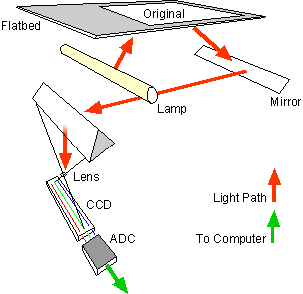Read this simple summary to learn how your document is transmitted from in your hand to onto your PC.
- A document is placed on the glass plate and the cover is closed. The inside of the cover is a uniform color, generally white which enables the scanner to determine the size of the document being scanned.
- A light is then shined to light up the document.
- The scan head is made up of mirrors, lenses, filters and a CCD array. The scan head is attached to a belt which is rotated by a motor. When the motor turns the belt moves which causes the scan head to move across the illuminated document.
- To prevent the scan head from shaking whilst going across the document, it is attached to a stabilizer bar.

- Whilst the scan head is moving along it reflects the illuminated image onto a mirror which in turn reflects the image onto another mirror. Each mirror is curved. The purpose of reflecting the image from mirror to mirror is to minimize the size of the image to enable it to fit on the lens. Some scanners have 2 curved mirrors whilst others have 3.
- The last mirror reflects the image onto the lens. The image then goes from the lens through the filter onto the CCD array.
What is the CCD array?
CCD is a collection of tiny light sensitive particles, which convert light into electrical power. The particles are very sensitive to light, the stronger the light that hits the particle, the stronger electrical charge will be created. The scanner will detect the strength of the electrical charge and then creates the color and resolution of the image accordingly.
- The scanner software will then send the image to your computer.
Make sure you take a look at our blog post ‘Some Useful Scanning Tips’ to learn how to get best results from your scanner.
